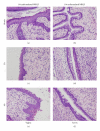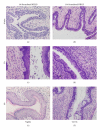Cervicovaginal safety of the formulated, biguanide-based human immunodeficiency virus type 1 (HIV-1) inhibitor NB325 in a murine model
- PMID: 22131821
- PMCID: PMC3202145
- DOI: 10.1155/2011/941061
Cervicovaginal safety of the formulated, biguanide-based human immunodeficiency virus type 1 (HIV-1) inhibitor NB325 in a murine model
Abstract
Vaginal microbicides that reduce or eliminate the risk of HIV-1 sexual transmission must do so safely without adversely affecting the integrity of the cervicovaginal epithelium. The present studies were performed to assess the safety of the biguanide-based antiviral compound NB325 in a formulation suitable for topical application. Experiments were performed using a mouse model of cervicovaginal microbicide application, which was previously shown to be predictive of topical agent toxicity revealed in microbicide clinical trials. Mice were exposed vaginally to unformulated NB325 or NB325 formulated in the hydroxyethyl cellulose "universal placebo." Following exposures to formulated 1% NB325 for 10 min to 24 h, the vaginal and cervical epithelia were generally intact, although some areas of minimal vaginal epithelial damage were noted. Although formulated NB325 appeared generally safe for application in these studies, the low but observable level of toxicity suggests the need for improvements in the compound and/or formulation.
Figures







Similar articles
-
Specific interactions between the viral coreceptor CXCR4 and the biguanide-based compound NB325 mediate inhibition of human immunodeficiency virus type 1 infection.Antimicrob Agents Chemother. 2009 Feb;53(2):631-8. doi: 10.1128/AAC.00866-08. Epub 2008 Dec 1. Antimicrob Agents Chemother. 2009. PMID: 19047650 Free PMC article.
-
Persistent interactions between biguanide-based compound NB325 and CXCR4 result in prolonged inhibition of human immunodeficiency virus type 1 infection.Antimicrob Agents Chemother. 2010 May;54(5):1965-72. doi: 10.1128/AAC.00934-09. Epub 2010 Mar 15. Antimicrob Agents Chemother. 2010. PMID: 20231400 Free PMC article.
-
Mouse model of cervicovaginal toxicity and inflammation for preclinical evaluation of topical vaginal microbicides.Antimicrob Agents Chemother. 2004 May;48(5):1837-47. doi: 10.1128/AAC.48.5.1837-1847.2004. Antimicrob Agents Chemother. 2004. PMID: 15105142 Free PMC article.
-
A novel vaginal microbicide containing the rationally designed anti-HIV compound HI-443 (N'-[2-(2-thiophene)ethyl]-N'-[2-(5-bromopyridyl)] thiourea]).Expert Opin Investig Drugs. 2012 Mar;21(3):265-79. doi: 10.1517/13543784.2012.655422. Epub 2012 Feb 1. Expert Opin Investig Drugs. 2012. PMID: 22292483 Review.
-
Clinical development of microbicides for the prevention of HIV infection.Curr Pharm Des. 2004;10(3):315-36. doi: 10.2174/1381612043386374. Curr Pharm Des. 2004. PMID: 14754390 Review.
Cited by
-
Infection by CXCR4-Tropic Human Immunodeficiency Virus Type 1 Is Inhibited by the Cationic Cell-Penetrating Peptide Derived from HIV-1 Tat.Int J Pept. 2012;2012:349427. doi: 10.1155/2012/349427. Epub 2012 Jan 29. Int J Pept. 2012. PMID: 22319541 Free PMC article.
-
Decreased cervical epithelial sensitivity to nonoxynol-9 (N-9) after four daily applications in a murine model of topical vaginal microbicide safety.BMC Pharmacol Toxicol. 2012 Oct 1;13:9. doi: 10.1186/2050-6511-13-9. BMC Pharmacol Toxicol. 2012. PMID: 23025553 Free PMC article.
References
-
- Joint United Nations Programme on HIV/AIDS (UNAIDS) Global report: UNAIDS report on the global AIDS epidemic 2010. 2010, http://www.unaids.org/globalreport/Global_report.htm.
-
- Balzarini J, Van Damme L. Microbicide drug candidates to prevent HIV infection. Lancet. 2007;369(9563):787–797. - PubMed
-
- Ramjee G. Microbicide research: current and future directions. Current Opinion in HIV and AIDS. 2010;5(4):316–321. - PubMed
-
- Nuttall J. Microbicides in the prevention of HIV infection: current status and future directions. Drugs. 2010;70(10):1231–1243. - PubMed
-
- Zydowsky TM. Microbicides: chemistry, structure, and strategy. Current Opinion in HIV and AIDS. 2008;3(5):548–553. - PubMed
Publication types
MeSH terms
Substances
Grants and funding
LinkOut - more resources
Full Text Sources
Medical
